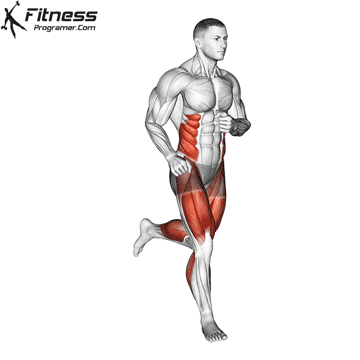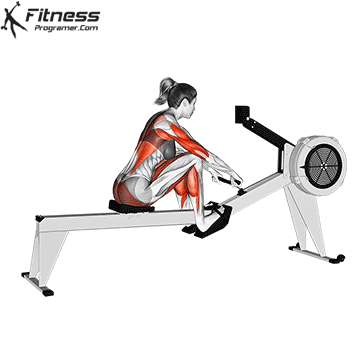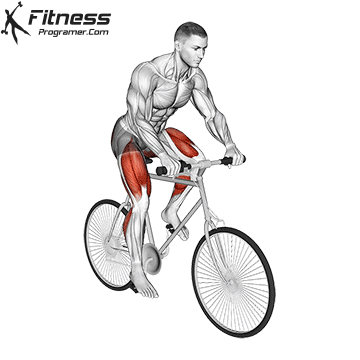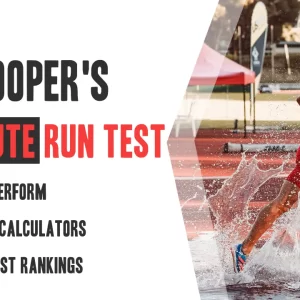Contents
Are you looking for a powerful way to enhance your cardiovascular health and elevate your overall fitness? Understanding and improving your VO₂ max is a critical step. A higher VO₂ max doesn’t just mean you can run faster or cycle longer; it’s directly linked to a stronger heart, improved cardiovascular endurance, and a reduced risk of various chronic diseases.
I’m Alexandra Botez from the Fitnessprogramer team. In this article, I’ll explain what VO₂ max truly means, why it’s so important for your well-being, and provide practical, evidence-based strategies you can implement to optimize your quality of life for a healthier, fitter life.
What Is VO₂ Max?
VO₂ max—short for maximal oxygen uptake—refers to the maximum amount of oxygen your body can utilize during intense exercise. It is considered the gold standard for measuring cardiorespiratory fitness.
VO₂ max is measured in milliliters of oxygen used per kilogram of body weight per minute (ml/kg/min). The higher your VO₂ max, the more oxygen your body can deliver to working muscles, enhancing endurance and athletic performance.
Why VO₂ Max Matters
1. Indicator of Cardiovascular Health
VO₂ max is strongly associated with overall heart and lung function. Low VO₂ max values are linked to a higher risk of cardiovascular disease, diabetes, and early mortality (Kodama et al., 2009).
2. Predictor of Athletic Potential
For endurance athletes, VO₂ max can determine performance limits. While not the sole factor for success, elite runners, cyclists, and rowers often possess very high VO₂ max levels (up to 85 ml/kg/min in males).
3. Tool for Training Optimization
Tracking VO₂ max allows athletes and coaches to individualize training programs, monitor adaptations, and fine-tune intensity zones.
How Is VO₂ Max Measured?
Laboratory Testing (Gold Standard)
Direct VO₂ max testing is the most accurate method, involving real-time measurement of your oxygen consumption and carbon dioxide output during a graded exercise test (GXT), usually performed on a treadmill or cycle ergometer.
| Pros | Cons |
|---|---|
| High accuracy | Requires specialized equipment |
| Individualized data | Must be supervised by trained professionals |
| Useful for elite athletes and clinical settings | Physically demanding |
Who Should Use It:
- Endurance athletes
- Clinical patients undergoing cardiopulmonary assessment
- Researchers needing high-fidelity data
Field Tests and Estimations
When lab testing isn’t available, indirect assessments estimate VO₂ max using performance data and predictive equations. While not as precise, they offer practical, accessible alternatives.
- 1.5-mile run test
- Rockport walk test
- Cooper test (12-minute run)
- Step tests
VO₂ Max Norms by Age and Gender
Men
| Age | Superior | Excellent | Good | Fair | Poor | Very Poor |
|---|---|---|---|---|---|---|
| 20–29 | ≥66.3 | 59.3–66.2 | 53.7–59.2 | 48.0–53.6 | 41.9–47.9 | ≤41.8 |
| 30–39 | ≥59.8 | 54.2–59.7 | 48.0–54.1 | 42.4–47.9 | 37.4–42.3 | ≤37.3 |
| 40–49 | ≥55.6 | 49.3–55.5 | 43.9–49.2 | 37.8–43.8 | 33.3–37.7 | ≤33.2 |
| 50–59 | ≥50.7 | 43.2–50.6 | 38.2–43.1 | 32.6–38.1 | 28.4–32.5 | ≤28.3 |
Women
| Age | Superior | Excellent | Good | Fair | Poor | Very Poor |
|---|---|---|---|---|---|---|
| 20–29 | ≥56.0 | 48.3–55.9 | 43.2–48.2 | 37.6–43.1 | 32.0–37.5 | ≤31.9 |
| 30–39 | ≥45.8 | 39.3–45.7 | 34.6–39.2 | 30.2–34.5 | 26.4–30.1 | ≤26.3 |
| 40–49 | ≥41.7 | 36.0–41.6 | 31.1–35.9 | 26.7–31.0 | 23.3–26.6 | ≤23.2 |
| 50–59 | ≥35.9 | 30.2–35.8 | 26.8–30.1 | 23.4–26.7 | 20.6–23.3 | ≤20.5 |
American College of Sports Medicine (ACSM). ACSM’s Guidelines for Exercise Testing and Prescription, 10th Edition, 2017.
Factors That Influence VO₂ Max
- Genetics: Can account for 20–50% of VO₂ max potential
- Age: VO₂ max naturally declines by ~1% per year after age 25–30
- Sex: Men typically have higher VO₂ max due to greater muscle mass and hemoglobin levels
- Training Status: Well-trained individuals have significantly higher values
- Altitude & Environment: High altitudes may lower VO₂ max; training in heat can influence adaptation
VO₂ Max Training Zones (Approximate)
| Zone | % of VO₂ Max | % of Max HR | Intensity |
|---|---|---|---|
| Zone 1 | 50–60% | 60–70% | Light (recovery) |
| Zone 2 | 60–70% | 70–75% | Moderate (aerobic base) |
| Zone 3 | 70–80% | 75–85% | Tempo/Lactate Threshold |
| Zone 4 | 80–90% | 85–90% | Hard (VO₂ max training) |
| Zone 5 | 90–100% | 90–100% | Very hard (sprints) |
In most training programs, we use heart rate % because it’s easier to measure. But heart rate zones often correlate closely with VO₂ max zones.
How to Improve VO₂ Max
1. High-Intensity Interval Training (HIIT)
High-Intensity Interval Training (HIIT) is among the most efficient and research-backed ways to increase VO₂ max. By alternating intense efforts with recovery periods, HIIT stimulates both central and peripheral cardiovascular adaptations.
A. 4×4 Norwegian HIIT
The 4×4 Norwegian HIIT protocol is a high-intensity aerobic interval training method developed and researched by Norwegian exercise physiologists, including Dr. Ulrik Wisløff and colleagues at the Norwegian University of Science and Technology. Studies show that this is consistent with observed changes in VO2max (Jan Helgerud et al.).
It involves:
- 4 intervals
- 4 minutes each
- Performed at 90–95% of maximum heart rate (HRmax)
- Interspersed with 3 minutes of active recovery at 60–70% HRmax
This protocol typically lasts about 35–40 minutes including warm-up and cooldown and is performed 2–3 times per week.
You could choose activities like running, swimming, rowing, cycling, or high-intensity bodyweight exercises.




Sample Workout:
- 8-10 Min: warm-up
- 4 Min: Rowing (Hard pace or 85–95% HRmax)
- 3 Min: Active Recovery (60–70% HRmax)
- 4 Min: Rowing (Hard pace or 85–95% HRmax)
- 3 Min: Active Recovery (60–70% HRmax)
- 4 Min: Rowing (Hard pace or 85–95% HRmax)
- 3 Min: Active Recovery (60–70% HRmax)
- 4 Min: Rowing (Hard pace or 85–95% HRmax)
- 3 Min: Active Recovery (60–70% HRmax)
- 5 Min: Cooldown
Progression Plan (Weeks 1–4)
| Week | Intervals | Notes |
|---|---|---|
| Week 1 | 4 x 2 min | Build tolerance to intensity; maintain >85% HRmax |
| Week 2 | 4 x 3 min | Aim for 85–90% HRmax |
| Week 3 | 4 x 4 min | Full protocol; Maintain HR between 90–95%; control breathing |
| Week 4 | 4 x 4 min | Add incline or resistance (bike) to increase challenge |
Cautions and Considerations
- HR monitoring is essential to stay in the right intensity range
- Avoid back-to-back HIIT days—recovery is crucial for adaptation
- Warm up thoroughly to avoid injury or overexertion
- Those with heart conditions should consult a physician before attempting
B. Sprint Interval Training (SIT):
SIT provides a powerful and scientifically proven method to elevate VO₂ max—fast (Hazell et al.). Sprint Interval Training (SIT) is a highly intense form of anaerobic training that consists of repeated maximal-effort sprints interspersed with long recovery periods. Unlike HIIT, which typically operates at 85–95% of maximum heart rate, SIT involves maximal (100%) efforts, typically lasting 20–30 seconds.
- 30 seconds all-out (Wingate style) x 4–6 rounds
- 4 minutes recovery
- Induces rapid VO₂ max improvements, especially in untrained individuals
Sample SIT Session (Cycle-Based)
| Phase | Details |
|---|---|
| Warm-Up | 5–10 min at 60–65% HRmax (Zone 2) |
| Sprint Intervals | 4 × 30 sec max sprint @ 100% effort |
| Recovery | 4 min light cycling or walking |
| Cooldown | 5 min at low intensity + stretch |
Progression Plan (Weeks 1–4)
| Week | Sprints | Rest Time | Session Frequency |
|---|---|---|---|
| Week 1 | 3 x 30 sec | 4 min | 2/week |
| Week 2 | 4 x 30 sec | 4 min | 2/week |
| Week 3 | 5 x 30 sec | 3.5 min | 2–3/week |
| Week 4 | 6 x 30 sec | 3 min | 3/week |
Safety and Cautions
- SIT is extremely demanding and should not be the starting point for people with cardiovascular risk factors or orthopedic limitations.
- Always perform a 5–10 min warm-up and include a cooldown.
- Use low-impact equipment (stationary bike, rower) for joint safety.
2. Zone 2 Endurance Training
Zone 2 training refers to sustained, moderate-intensity aerobic exercise performed at approximately 60–70% of your maximum heart rate (HRmax), or around 65–75% of VO₂ max. While high-intensity workouts provide an acute stimulus to raise VO₂ max, Zone 2 is responsible for building the aerobic base that allows you to:
- Use oxygen more efficiently at all intensities
- Sustain higher intensities for longer
- Recover faster between intervals
Examples of Zone 2 Workouts
- Running or cycling at a steady conversational pace for 45–90 minutes
- Rowing, swimming, or elliptical at moderate intensity
- 2–4 sessions per week for beginners; 4–6+ sessions for experienced athletes
Elite endurance athletes spend up to 80% of their training volume in Zone 2, based on the polarized training model (Seiler & Kjerland, 2006). It’s not flashy, but it’s highly effective for long-term cardiovascular gains.
3. Tempo and Threshold Runs
Tempo and threshold runs are strategic endurance workouts performed at or just below your lactate threshold (LT)—the intensity at which lactate begins to accumulate in the bloodstream faster than it can be cleared. This point typically occurs around 80–90% of your maximum heart rate or 75–85% of VO₂ max.
Training near this physiological boundary enhances your aerobic power, delays fatigue, and significantly boosts your VO₂ max by increasing the efficiency with which your body uses oxygen under high-stress conditions.
What Are Tempo and Threshold Runs?
While the terms are often used interchangeably, there are subtle differences:
- Tempo Runs (aka steady-state runs): Performed at a comfortably hard pace you can sustain for 20–40 minutes. Great for building aerobic strength and mental toughness.
- Threshold Runs: Slightly more structured and precise, targeting your individual lactate threshold (often determined by testing or using heart rate zones).
Workout Example: Classic Lactate Threshold Run
- Warm-up: 10–15 minutes of easy jogging
- Main set: 20–30 minutes at 80–90% of HRmax (or a pace you could maintain for about an hour in a race)
- Cool-down: 5–10 minutes of easy running
- Rate of Perceived Exertion (RPE): 7–8 out of 10
- Breathing test: You can speak in short phrases, but full conversation is difficult.
- Frequency: 1–2 sessions per week
Threshold training is effective but stressful on the body. Recovery is essential. Beginners can start with “cruise intervals” (e.g., 3 x 10 minutes with 1–2 minutes rest) to manage intensity without overreaching.
Practical Tips to Track Progress
- Use wearable fitness trackers that estimate VO₂ max during workouts
- Perform regular field tests (e.g., 12-minute run)
- Monitor resting heart rate and perceived effort at a given pace
- Reassess every 4–6 weeks during a structured training program
VO₂ Max in Special Populations
Aging Adults
Although VO₂ max decreases with age, consistent aerobic training can slow the decline and preserve functional capacity, mobility, and independence.
Sedentary Individuals
Even moderate physical activity can lead to large VO₂ max gains in previously inactive individuals (Swain & Franklin, 2006).
Women
Though women typically have lower VO₂ max due to physiological differences, they respond similarly to training, making structured aerobic and interval training beneficial.
Frequently Asked Questions
VO₂ Max % vs. Heart Rate % — What’s the Difference?
| Measurement | Definition | How It’s Measured | Training Use |
|---|---|---|---|
| Heart Rate % (HR%) | % of your max heart rate | HRmax = 220 − your age. Let’s say you’re 30 years old. HRmax = 220 − 30 = 190 bpm | Easy to use for daily training |
| VO₂ Max % | % of your oxygen utilization max | Requires lab testing or field testing | Used in elite & scientific training |
Is a high VO₂ max always better?
A high VO₂ max reflects aerobic potential, but performance depends on other factors like lactate threshold, economy of movement, and mental resilience.
Can VO₂ max be too low?
Yes. A low VO₂ max (<30 ml/kg/min) is associated with increased risk for cardiovascular and metabolic diseases.
How quickly can VO₂ max improve?
With consistent training, improvements of 10–20% can be seen in 6–12 weeks depending on the individual’s fitness level and training intensity.
Conclusion
VO₂ max is one of the most important and telling metrics in exercise science. Whether you’re an elite athlete or a beginner looking to improve your cardiovascular health, increasing your VO₂ max through strategic training can significantly enhance performance, energy levels, and long-term health outcomes.
Remember: You don’t need to chase elite-level numbers—incremental improvement matters and reflects meaningful gains in health and endurance.
References
- Kodama, S., et al. (2009). Cardiorespiratory fitness as a quantitative predictor of all-cause mortality and cardiovascular events: a meta-analysis. JAMA, 301(19), 2024–2035. https://doi.org/10.1001/jama.2009.681
- Bassett, D. R., & Howley, E. T. (2000). Limiting factors for maximum oxygen uptake and determinants of endurance performance. Medicine and Science in Sports and Exercise, 32(1), 70–84. https://doi.org/10.1097/00005768-200001000-00012
- Swain, D. P., & Franklin, B. A. (2006). Comparison of cardioprotective benefits of vigorous vs. moderate intensity aerobic exercise. American Journal of Cardiology, 97(1), 141–147. https://doi.org/10.1016/j.amjcard.2005.07.130
- Hazell et al. 10 or 30-s sprint interval training bouts enhance both aerobic and anaerobic performance https://pubmed.ncbi.nlm.nih.gov/20424855/
- Jan Helgerud et al. Aerobic high-intensity intervals improve VO2max more than moderate training https://pubmed.ncbi.nlm.nih.gov/17414804/
- American College of Sports Medicine. (2021). ACSM’s Guidelines for Exercise Testing and Prescription (11th ed.).



